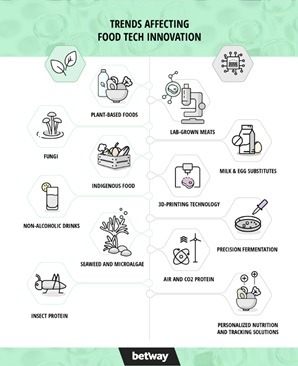Whether you’re interested in food sustainability, you want to eat less meat or you simply just love food there is no denying that food over recent years has changed. We’re seeing a much wider variety of foods with unusual flavours and meat-free alternatives becoming more and more popular. Although lots of this is driven by consumer demand, it is also the ever-evolving technology that is helping to change and adapt the food that is available to us.
What is Food Tech?
Before diving into the emerging trends in food technology, let’s try to understand what exactly food tech is. In simple words, it is a branch of science that involves studying techniques and ways to process and preserve food items. It allows us to develop and produce food products that are safe, nutritious, and considerate of the present environmental challenges of the world. Its application has resulted in the wide variety of food items in supermarkets. It is becoming an increasingly important industry nowadays.
Traceability For Food
One thing that consumers are starting to become keener on and that technology is making easier for us to do is the traceability of food. People want to know where their food has come from and the journey it has taken to reach their plate. We’re starting to see more data emerge about what is in food and what processes it has gone through before reaching us. As a generation that is thinking about sustainability and environmental factors, people are starting to become more aware of the impact their food choices have on the environment and are becoming keener to ensure that their food choices don’t impact this too much.
With plans by different health organisations to reduce the gas emissions that the food industry are responsible for by 2050, these new ways of eating and the technology behind them have an important role to play. A big part of reducing carbon emissions is to reduce the amount of meat that we eat and as such, things like tracing products and alternative meat options will be high on the list to help make this happen.
Alternative Proteins
The number of vegetarians and vegans across the globe has increased dramatically over recent years and this is a trend that is set to continue. Some of this will be down to the preference of not wanting to eat animal products and some will be down to the accessibility of meat alternative products. There are now so many plant-based proteins on the market that whatever your taste in food is, you should find it easy to find meat alternatives to try. This not only means that preparing vegan meals at home is easy, but it means that there number of meat-free but high protein meals in restaurants is higher than ever. With so many people responding positively to this change, it is something that is likely to continue as technology continues to expand and grow.
Intuitive Eating
We’re starting to become aware of the health benefits of eating the right foods. We have known for a long time that a varied diet and everything in moderation is good for us, but thanks to technology we now know what foods can actually benefit us. Technology has allowed us to create food with extra protein, or rich in vitamins and it is something that the consumer market is responding well to. People are starting to understand the importance of fuelling their bodies in the right way and technology is certainly helping this.
Nutraceuticals
All around the world, we are seeing increasing concern and awareness about the impact of diet and the food products we are consuming. This has led to rising demand for nutrients that are necessary for leading a healthy life. This has been even more exaggerated with the COVID-19 pandemic as healthy eating has remained the top trend which is driving demand for nutraceuticals. Nutraceuticals include supplements, medicinal food items, and drugs to boost your gut microbiome. Studies have shown that nutraceuticals have had a positive impact on health, reduce chances of disease, and support the function of the body, however, it remains a widely unregulated industry in the U.S. and many countries around the world. Nevertheless, we see increasing demand for this industry and it is on a path to be the next big thing in the food tech industry.
Food Waste Reduction
According to UN Environment Programme, around one-third of the food eligible for human consumption is wasted every year which is around 1.3 billion tonnes. As such, focusing on food waste reduction is vital to address the food insecurity that exists around the world. We are seeing an emergence of new technologies, ways, and techniques by different corporate entities and entrepreneurs that are reducing the food waste in an attempt to reduce the impact on the environment and become more efficient in operations thus saving costs as well. Many businesses are also shifting to zero waste plans and recycling to reach customers that are concerned about sustainability.
Food Standards Compliance
Due to the complexity and sophistication in our world’s food supply chain, compliance with the global food standards is becoming a norm, specifically food safety standards. One such organization that is dealing with these standards is called the Global Food Safety Initiative (GSFI) which has a list of verified and certified programs that audit and inspect every step of the supply chain from manufacturing to labelling to delivering. Rising transparency and traceability globally has led to this food tech trend that is likely to continue in the foreseeable future.
Conclusion
Many new trends are emerging in food tech including traceability, alternative proteins, intuitive eating, nutraceuticals, food waste programmes, and global food safety standards. The surge in development for food tech is primarily driven by the fact that people all around the world are focusing more on their diet. This, in turn, has been influenced by the increasing awareness about food products and their resultant impacts on your body. We see that internet and widespread access to information has increased this awareness about food products.




